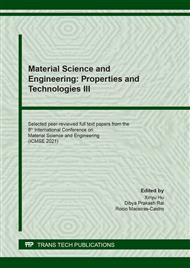p.29
p.37
p.43
p.53
p.59
p.67
p.73
p.81
p.89
Electrochemical Corrosion and Thermal Failure Mechanism of Buffer Layer
Abstract:
This paper studies the characteristics of white powder generation on the buffer layer of cables under the influence of humidity and pressure. After testing, the presence of white powder in the buffer layer leads to an increase in the volume resistivity (higher than the area without white powder). The denser the white powder, the more the volume resistivity rises. The current density and surface temperature is simulated in COMSOL and observed the process of white powder generation. The volume resistivity is also measured using an electrochemical impedance spectrometer with different contents of white powder in buffer layer. The test results show that the electrochemical corrosion increase on buffer layer under high water contents in the presence of large current density. The experimental results show that when the water content of the buffer layer is 2 mL, the formation rate of white powder is the fastest; when the pressure of the buffer layer in the range of 998.2 N/m2~9982 N/m2, the formation rate of white powder increases first, then decreases, and finally tends to be saturated; The main component of white powder is aluminum oxide, which is formed by chemical corrosion and electrochemical corrosion of aluminum, carbon black, sodium polyacrylate, water and etc.
Info:
Periodical:
Pages:
59-64
Citation:
Online since:
March 2022
Authors:
Price:
Сopyright:
© 2022 Trans Tech Publications Ltd. All Rights Reserved
Share:
Citation:


